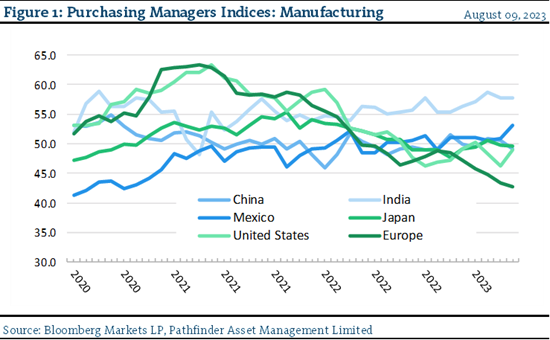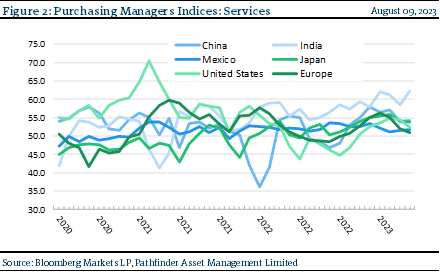The Management View
Regular readers of the Pathfinder Investment Outlook will recognize the Purchasing Managers Indices (PMIs) in Figures 1 and 2 below. PMI indices are calculated by taking a monthly survey of managers from a broad cross section of the global economy. In the survey, corporate managers are asked about their business intentions going forward (i.e. production, hiring, new orders, inventory targets, etc.). The answers to the survey are designed to be “yes” or “no”. This results in a weighted score with 50 as a base, such that a score of over 50 indicates a positive view, or expected business expansion, while a score under 50 indicates a negative view, or business contraction. The data is then aggregated into various sub-indices by company type like Manufacturing (e.g. Automotive, Machinery, and Textiles) or Services (e.g. Information Technology, Financial Services & Hospitality) or across all companies in aggregate like hiring, inventories, deliveries or new orders. They are also grouped by counties and geography and this is what we have presented in the charts below.
- In Figure 1, we selected the major economies of the world and plotted their Manufacturing PMIs – blue lines for Developing countries and green for Developed.
- We note the changing and opposite trends in Manufacturing PMIs for Developed vs Developing Markets. Counties like Europe, Japan and the US were strong at the end of 2020 but have since drifted into contraction. Countries like India, China and Mexico have improved significantly on the other hand.

- Figure 2 presents Services expectations for the same group. Notice how most counties have steadily increased into expansion for services over the past 2 years. All major economies are now above 50.
- We can conclude that manufacturing businesses have not been nearly as strong as service companies.

“This means that” a substantial part of the economy (services) looks relatively healthy. This is material for a country like the US, where two thirds of GDP is driven from the consumer. Manufacturing looks more balanced but there is some concern for countries like Germany, South Korea and China that are more exposed to manufacturing. We believe that ultimately consumers will feel a manufacturing slowdown. It is important to monitor industrial and manufacturing expectations.
National Instrument 31-103 requires registered firms to disclose information that a reasonable investor would expect to know, including any material conflicts with the firm or its representatives. Doug Johnson and/or Pathfinder Asset Management Limited are an insider of companies periodically mentioned in this report. Please visit www.paml.ca for full disclosures.
Changes in Leverage. We are increasing the asset ceiling to 2.0 times the market value of equity for Pathfinder International Fund and Pathfinder Real Fund to be consistent with Pathfinder Partners’ Fund and Pathfinder Resource Fund
*All returns are time weighted and net of investment management fees. Returns from the Pathfinder Partners’ Fund and Partners’ Real Return Plus Fund are presented based on the masters series of each fund. The Pathfinder Core: Equity Portfolio and The Pathfinder Core: High Income Portfolio are live accounts. These are actual accounts owned by the Pathfinder Chairman (Equity) and client (High Income) which contain no legacy positions, cash flows or other Pathfinder investment mandates or products. Monthly inception dates for each fund and portfolio are as follows: Pathfinder Core: Equity Portfolio (January 2011), Pathfinder Core: High Income Portfolio (October 2012) Partners’ Fund (April 2011), Partners’ Real Return Plus Fund (April, 2013), and Partners’ Core Plus Fund (November 2014).
Pathfinder Asset Management Limited (PAML) and its affiliates may collectively beneficially own in excess of 10% of one or more classes of the issued and outstanding equity securities mentioned in this newsletter. This publication is intended only to convey information. It is not to be construed as an investment guide or as an offer or solicitation of an offer to buy or sell any of the securities mentioned in it. The author has taken all usual and reasonable precautions to determine that the information contained in this publication has been obtained from sources believed to be reliable and that the procedures used to summarize and analyze such information are based on approved practices and principles in the investment industry. However, the market forces underlying investment value are subject to sudden and dramatic changes and data availability varies from one moment to the next. Consequently, neither the author nor PAML can make any warranty as to the accuracy or completeness of information, analysis or views contained in this publication or their usefulness or suitability in any particular circumstance. You should not undertake any investment or portfolio assessment or other transaction on the basis of this publication, but should first consult your portfolio manager, who can assess all relevant particulars of any proposed investment or transaction. PAML and the author accept no liability of any kind whatsoever or any damages or losses incurred by you as a result of reliance upon or use of this publication.